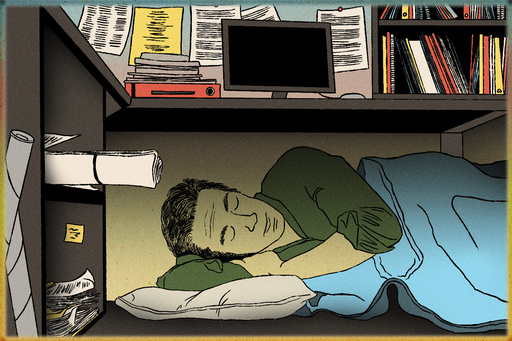
NEW YORK — Across the United States, a hidden community exists among workers who embrace napping as part of their daily routine. This phenomenon can be likened to a secret society, where individuals steal glimpses of sleep in parking lots, on quiet streets before the afternoon school rush, or in rented nap pods. Drawing inspiration from notable figures like Winston Churchill and Albert Einstein, modern napping enthusiasts often take short breaks to enhance their mental acuity, even though the practice still carries a degree of stigma.
Research has highlighted various advantages of napping, linking it to improved memory and concentration. In nations like Spain and Italy, an afternoon siesta is standard practice. Similarly, cultures in China and Japan often promote napping, viewing the act of working until exhaustion as a testament to one’s commitment, as noted in a published study in the journal Sleep.
However, the American work culture often discourages napping, sometimes labeling those who do so as indolent. In fact, federal regulations prohibit sleeping in government buildings during work hours, save for exceptional cases. Nevertheless, those daring enough to challenge conventional norms are increasingly open about the positive impacts of short sleep intervals. For instance, Marvin Stockwell, who heads the PR firm Champion the Cause, shares that his regular napping habit significantly enhances his creativity and productivity.
The importance of sleep cannot be overstated; it is as essential to health as nutrition and physical exercise, according to James Rowley, a program director at Rush University Medical Center. He attributes much of today’s sleep deprivation to technology, noting that while television used to be a primary distraction, smartphones now pose a bigger challenge for people trying to sleep.
Though academia may not be as supportive of napping practices due to continuous publishing pressures, Julianna Kirschner, a lecturer at the University of Southern California, finds ways to incorporate naps into her busy schedule. She notes the addictive nature of social media, which often leads to time slipping away unexpectedly, thereby disrupting sleep. Kirschner, like many others, finds herself needing a nap to recuperate from such distractions.
Experts suggest that the most effective naps should be kept short, ideally ranging from 15 to 20 minutes. Rowley offers insight into this, explaining that naps of longer duration can lead to grogginess, known as sleep inertia. He advises that those who rely on naps should also evaluate their nighttime habits to address any underlying sleep issues.
Timing is another critical aspect of napping. Mid-afternoon is considered the prime time for a nap, aligning with a natural decline in alertness. Conversely, napping after 6 p.m. may disrupt nighttime sleep patterns for those adhering to a daytime schedule, as explained by Michael Chee, director at the Centre for Sleep and Cognition in Singapore. Recent research backs this up, suggesting a 30-minute nap as optimal for both practicality and cognitive benefits. However, even shorter naps, sometimes just six minutes long, can aid learning and skill performance, according to Valentin Dragoi of the Center for Neural Systems Restoration.
While napping isn’t widely accepted in the U.S. workplace, some businesses are beginning to endorse it. Will Bryk, founder of an AI search startup, has introduced sleeping pods for his staff. Ice cream company Ben & Jerry’s has also maintained a napping space at their Vermont headquarters for many years. Likewise, Arianna Huffington, co-founder of the Huffington Post, has advocated for naps and sleep after experiencing exhaustion in 2007; she subsequently established nap rooms in her past workplaces and her current endeavor, Thrive Global.
Kirsten Perez, a 33-year-old marketing manager, shares her dedication to napping, recalling previous breaks in her car and now finding solace in short naps at her desk or bed while working from home. She sets her alarm for 15 minutes and emphasizes the noticeable improvement in her mood and reasoning ability after such rest.
In certain job sectors, naps are not only accepted but almost necessary. The Centers for Disease Control and Prevention advocates for nurses on night shifts to take naps, yet many struggle to find time or space to do so in their busy work environments. In response to this need, some entrepreneurs, like Neil Wong with his business Nap York, have created dedicated spaces for napping in Manhattan, offering the option to rent sleeping pods for a nominal fee. These spaces welcome everyone from busy commuters to medical staff, providing a much-needed sanctuary for restful breaks.
“In today’s fast-paced world, there are few places designed for rest outside of the home or a hotel,” Wong remarked. “Napping spaces are essential for promoting wellness among busy professionals.”

